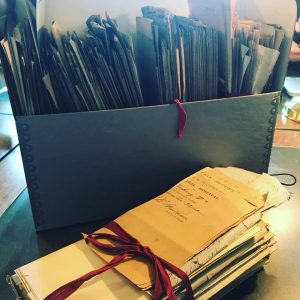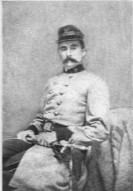A Needle in a Stack of Needles: Researching the Miscellaneous Medical Records Files at the National Archives
 Emerging Civil War welcomes back guest author Paige Gibbons-Backus.
Emerging Civil War welcomes back guest author Paige Gibbons-Backus.
At Ben Lomond Historic Site, we are constantly trying to find new information about its use as a hospital during the Civil War. Unfortunately, for historians, the records are scarce for numerous reasons. When the Pringle family home was converted into a hospital during the Battle of First Manassas, records were not routinely kept for the Confederacy was unprepared to handle the amount of wounded. Military forms meant for documentation such as roll calls or reports of sick and wounded went unfilled when staff could not get to them, or they simply ran out of forms to fill. In addition to this, many of the documents kept throughout the Confederacy burned when Richmond fell in April 1865. As a result, site staff and local historians have had to make conjectures about the state of the First Manassas hospitals based on better recorded hospitals, such as Portici, Sudley Church, or the ones located in Centreville. However, that does not stop us from trying to search for any documentation that might shed more light about the state of the local hospitals in 1861 Manassas or about Ben Lomond—the Pringle House—itself.
When I can get away from the site for a day, oftentimes I will go with volunteers or co-workers to the National Archives to search within the Miscellaneous Records of the Medical Department—Confederate War Department for any type of letter, form, or order related to the Northern Virginia/Manassas area or Ben Lomond. According to the finding aid, the records consist of reports of sick and wounded, requisitions for supplies, receipts, records of medical officers, and more between 1861-1865. However, these records not only cover the entirety of the war, but all theaters, and there is no rhyme or reason as to how these records are organized within the 30 boxes. As a result, we are required to flip through all the papers in all the boxes, one by one, hoping to come across a document that fits our criteria. While it is a very time-consuming and tedious process, (and there are many opportunities to get sucked into a rabbit hole of an interesting find) so far it has been a fruitful endeavor revealing not only a lot about the Manassas area at the beginning of the war, but a few interesting finds about Ben Lomond itself.

Many of the records that pertain to the Manassas area were written either from or to Dr. Thomas H. Williams, medical director and inspector of the Virginia hospitals. Dr. Williams joined the Confederate army in April 1861 after resigning from the United States Army at the start of the Civil War. On June 21st, he was appointed to the post of Medical Director and ordered to report to General Beauregard, who at the time was encamped in Manassas. While stationed at Manassas, the requests, demands, and questions he sent to the Medical Department, or received from other military personnel provide us with an idea of the challenges and issues facing the local hospitals at the beginning of the war.
Some of the most interesting letters that provide insight to these challenges relate to the use of supplies and the need for labor in the hospitals. For example, following the Battle of First Manassas, many men were pulled from the ranks and assigned to the hospitals to serve as nurses. This led to issues of authority and in October 1861, Williams sent a letter to the Medical Department requesting authority over soldiers who are serving in the hospitals. This request was sent for “the surgeons in charge of the General Hospitals are constantly annoyed by applications from regimental and company commanders for the return of their men who are employed as nurses as the hospitals.” Furthermore, “there are but few men who are willing to act in the capacity of nurses, and when one is obtained who is willing to wait upon the sick, and who becomes acquainted with the duties devoting upon him, it serves the interest of the service to retain him”. Just a month later, the need for nurses was still great for Williams wrote another letter in November requesting the ability to bring African Americans—we are not sure if they were free or enslaved—to the hospitals of Manassas. Williams writes:
Surgeon Anderson, C.S.A proceeded to Winchester a few days since for the purpose of hiring negros to act as nurses, and succeeded in securing fifteen but Gen’l Jackson refuses to permit them to leave Winchester, stating that the General commanding the Army of the Potomac had issued an order prohibiting negros from leaving that place. Negros must be obtained, or else heavy details must be asked from the army…
Not only was labor an issue, issues with supplies were discussed as well.

When we think of the Civil War hospitals and necessary supplies, we oftentimes think of medicine, clothing, food, and bandages, but one thing most people do not think of is ice. In December 1861, Dr. Williams sent again another letter to the Medical Department, this time requesting that icehouses be dug and constructed where necessary “for ice is an indispensable agent in the treatment of wounds and summer diseases, and advantage should be taken of the present season to secure as full a supply as possible.” Little did Williams know that the Confederate army would only remain in the Manassas area until March 1862 and would not be able to take advantage of those ice houses for the sick and wounded. Not only did Williams send requests for a variety of supplies, numerous others sent supply requests or complaints to him as well. In August 1861, a letter was sent from a Col. Withers of the 18th Virginia to Dr. Williams complaining about supplies that were used a month earlier and not replenished just prior to the battle in July 1861. Withers wrote:
We were ordered to send back to Manassas all the extra baggage and stores, which we could possibly be dispensed with. In obedience with this order, by my direction, the surgeon of this regiment boxed up and marked with his name a considerable supply of medicines and hospital stores, blankets, etc…. The surgeon [later] sent for them and was informed that they had been used on your order—if this is true, I hope you will take the necessary steps to have them replaced at your earliest convenience as from the amount of sickness is now in this Regiment, we are very much in need of them.
The excerpts of these letters are just a few of many that help provide insight to the state of medicine at the beginning of the Civil War—in this case specifically related to the Confederate army. However, this is just the beginning of four years of war, and while at the beginning both the Northern and Southern armies were unprepared for the bloody war that lie ahead, it would lead to several turning points throughout the war that would alter the course of medicine and the amount of lives lost throughout conflict.
Paige Gibbons Backus is the Historic Site Manager for Ben Lomond Historic Site, a Civil War hospital museum located in Manassas, VA. She has a B.A. in Historic Preservation from the University of Mary Washington and a M.A. in History from George Mason University.
Images:
Dr. Thomas Williams, from The Photographic History of the Civil War in Ten Volumes, edited by Robert Sampson Lanier, Francis Trevelyan Miller, 1911
National Archives Images taken by Paige Gibbons Backus
1 Response to A Needle in a Stack of Needles: Researching the Miscellaneous Medical Records Files at the National Archives